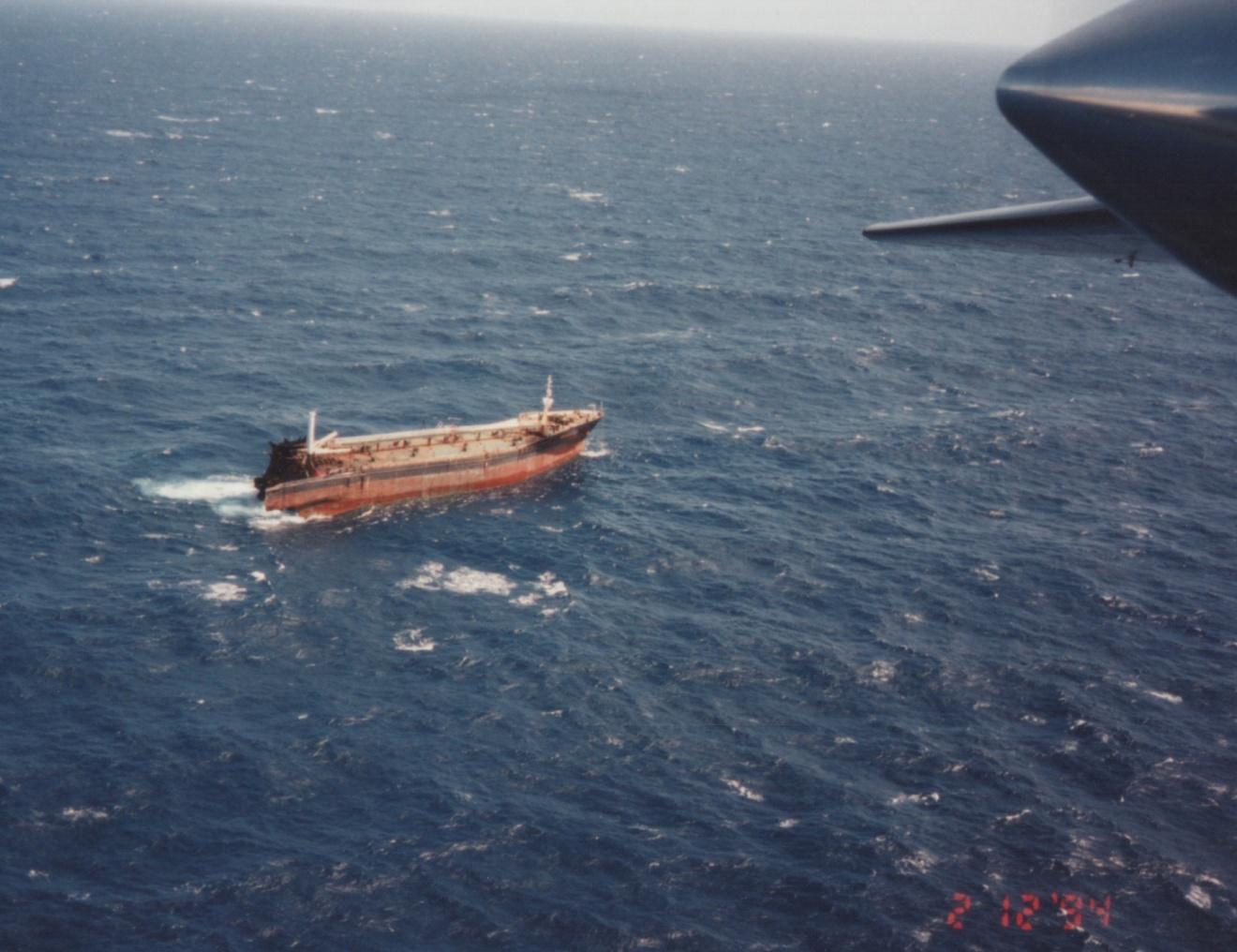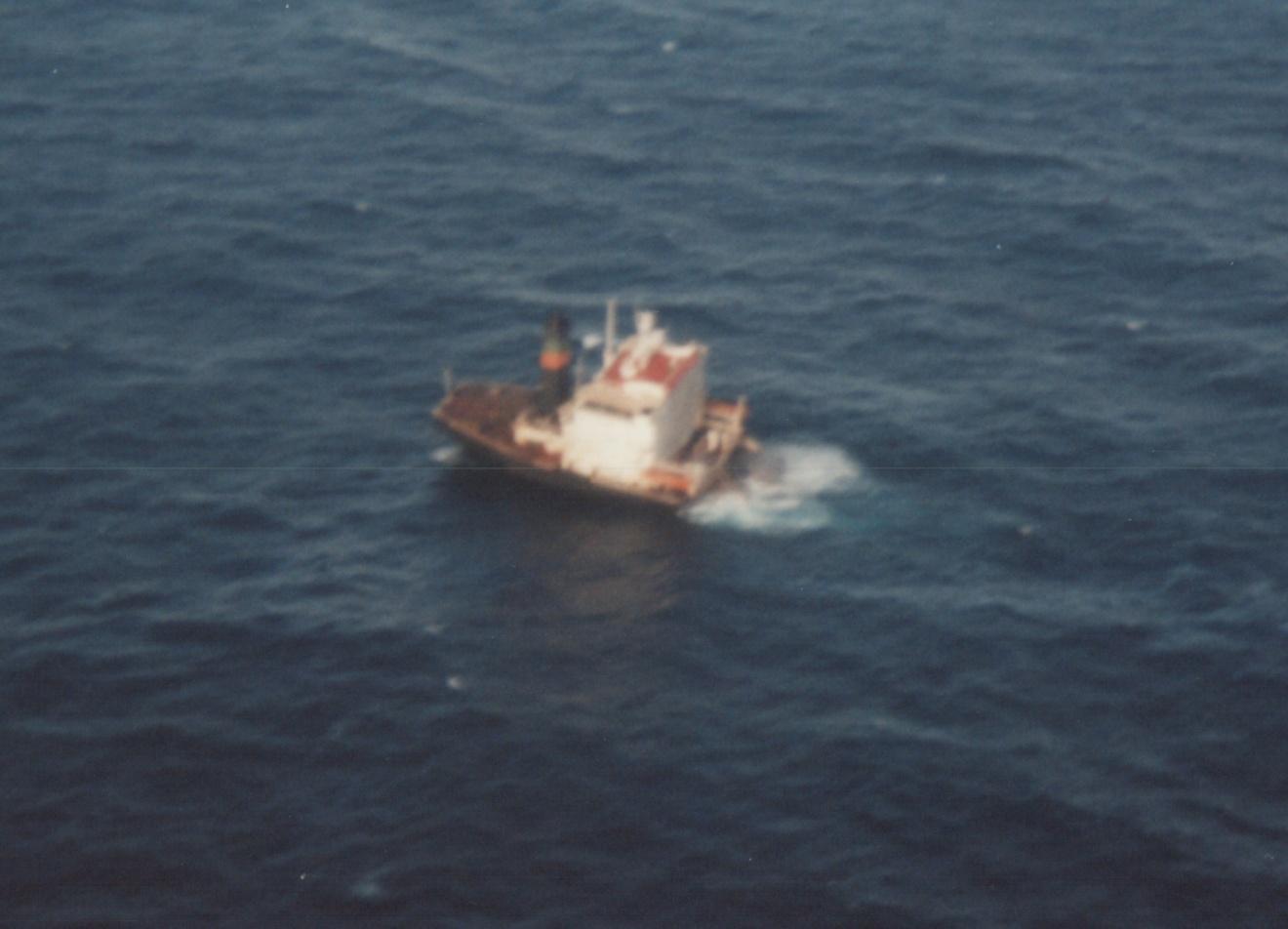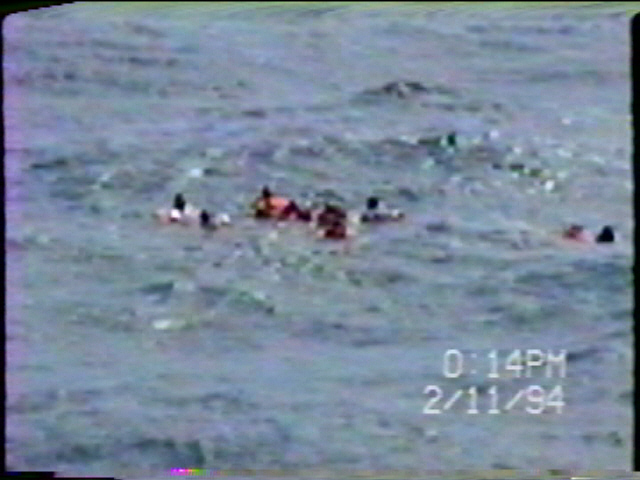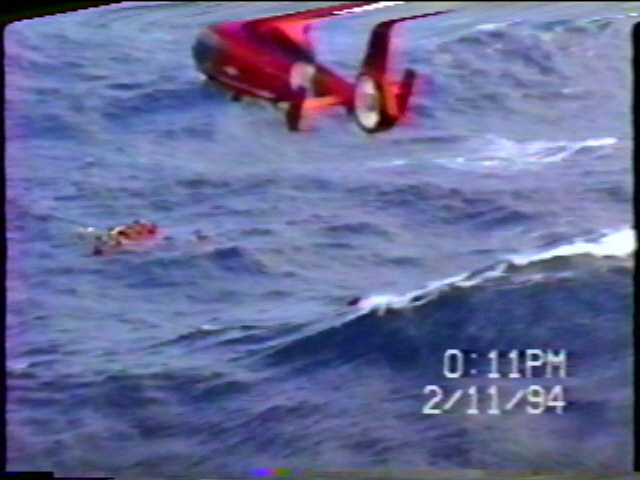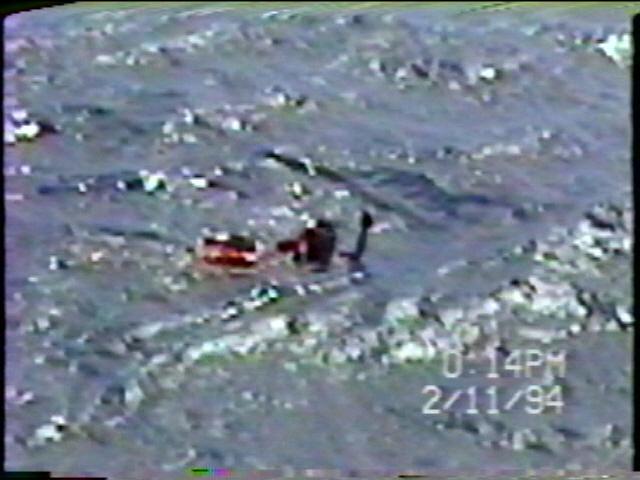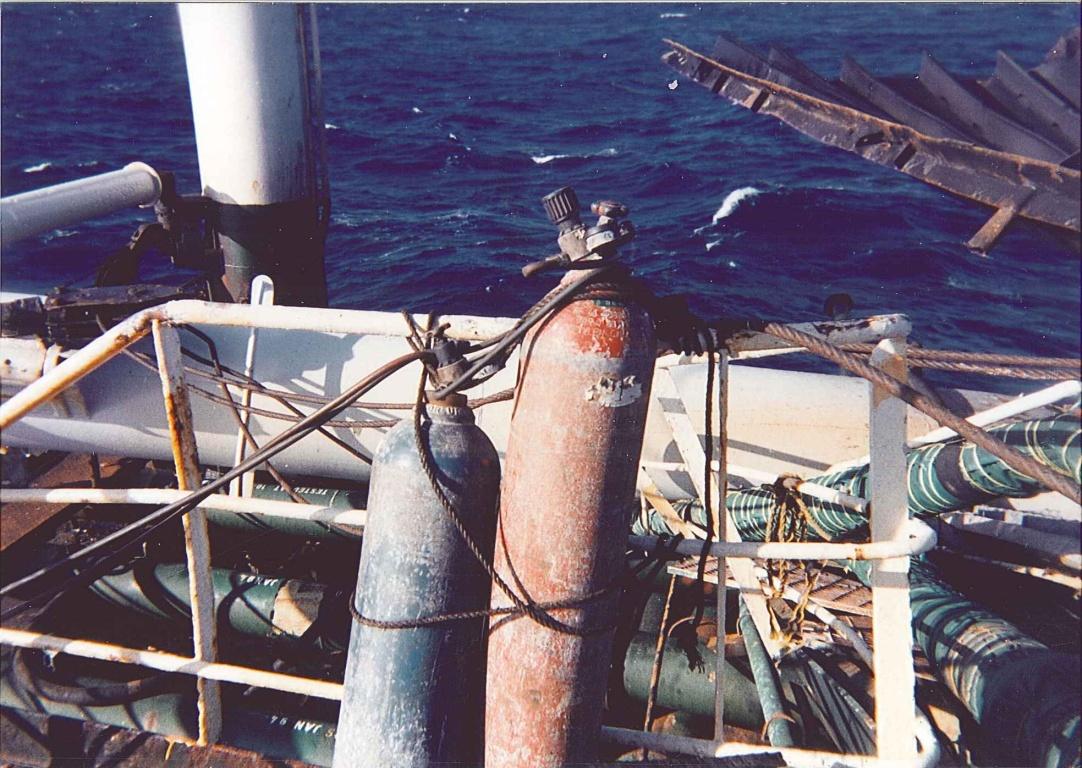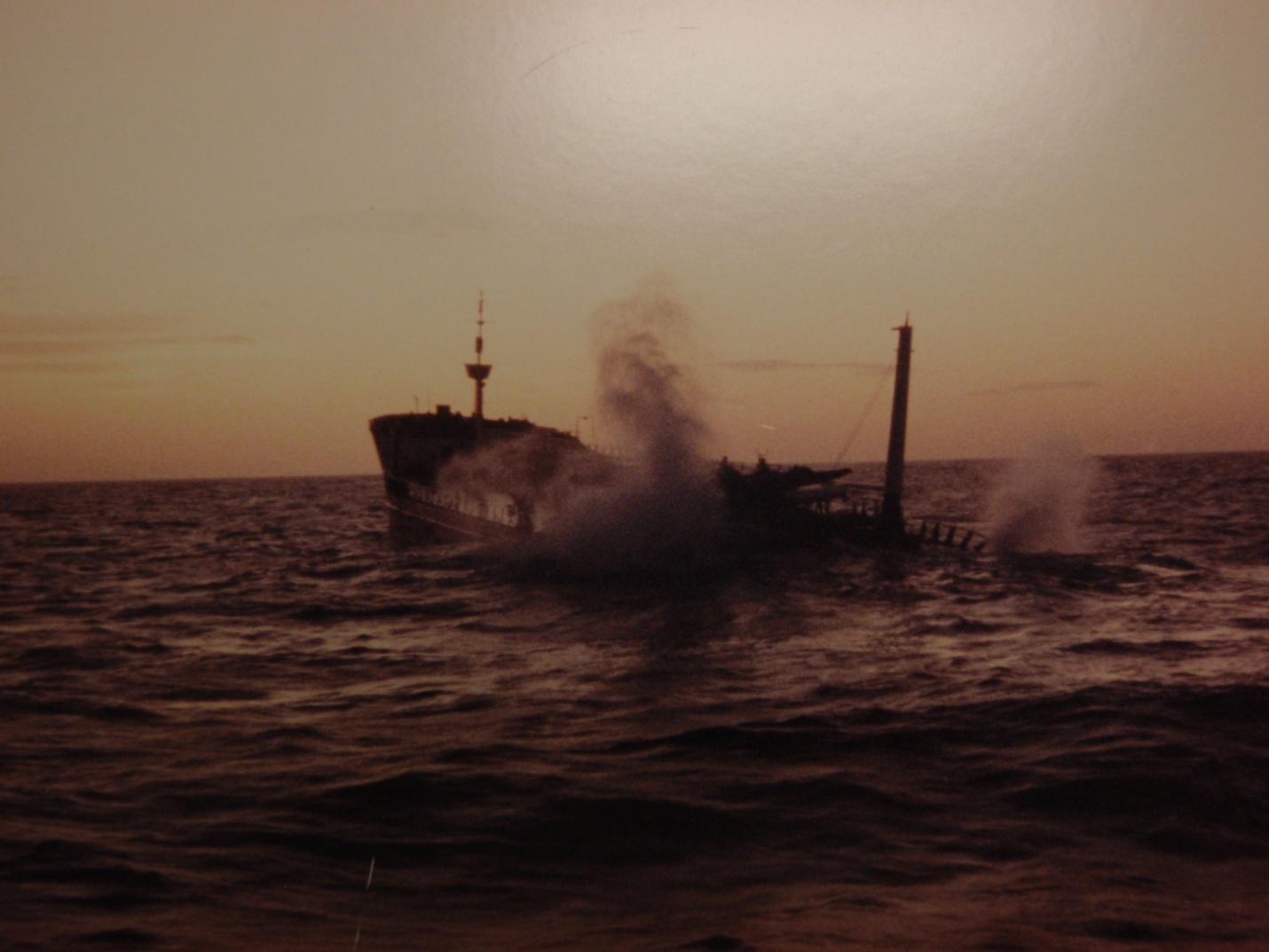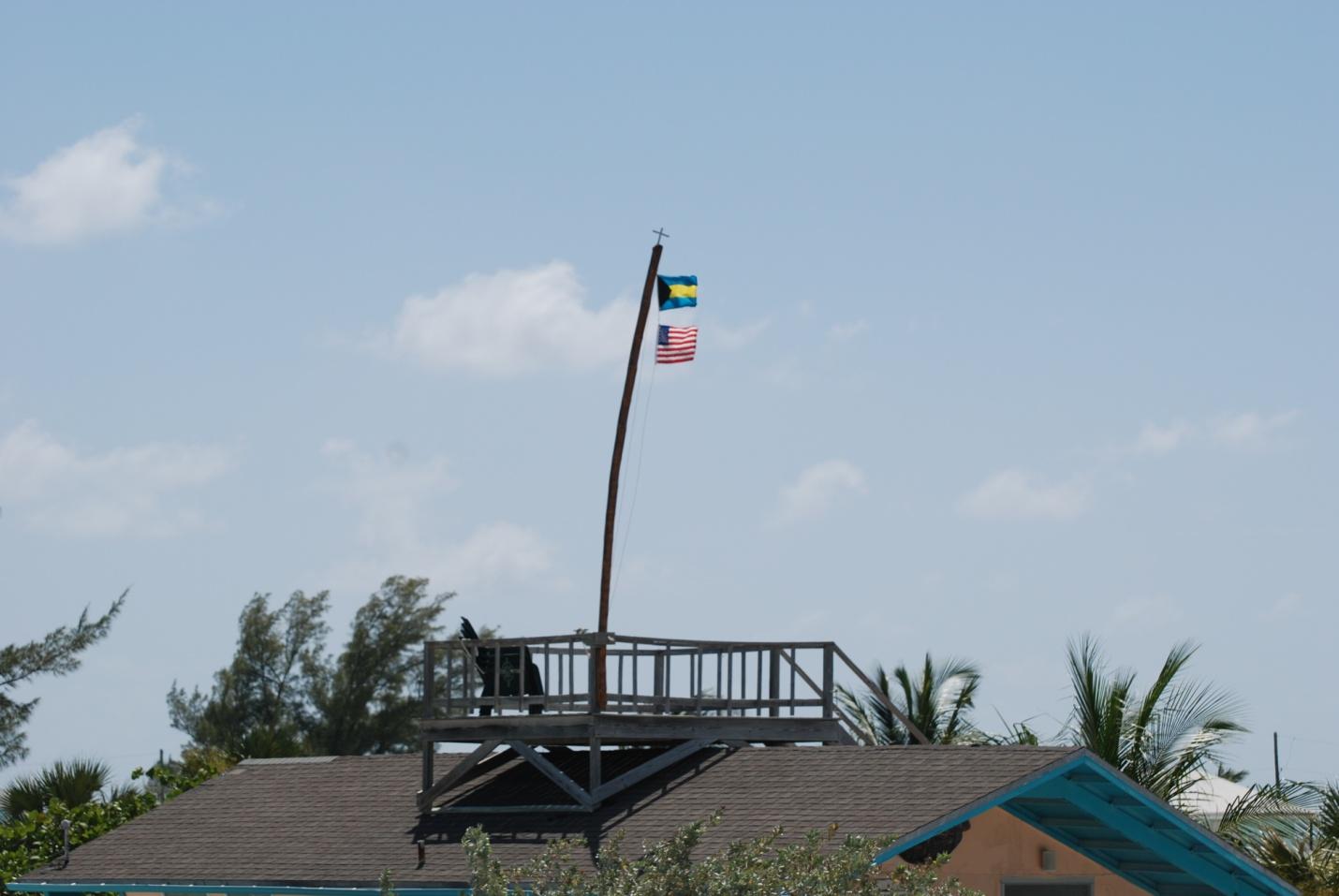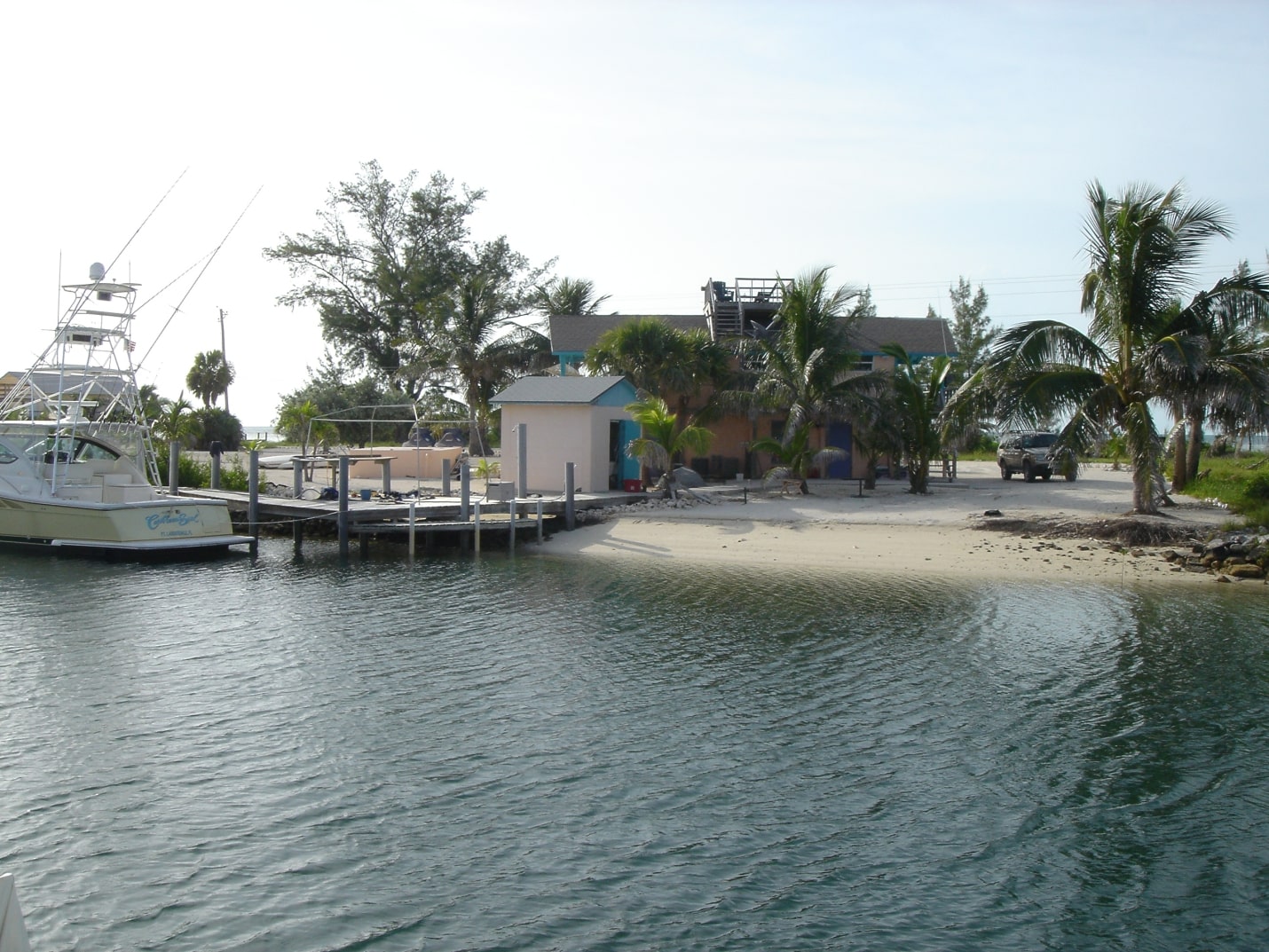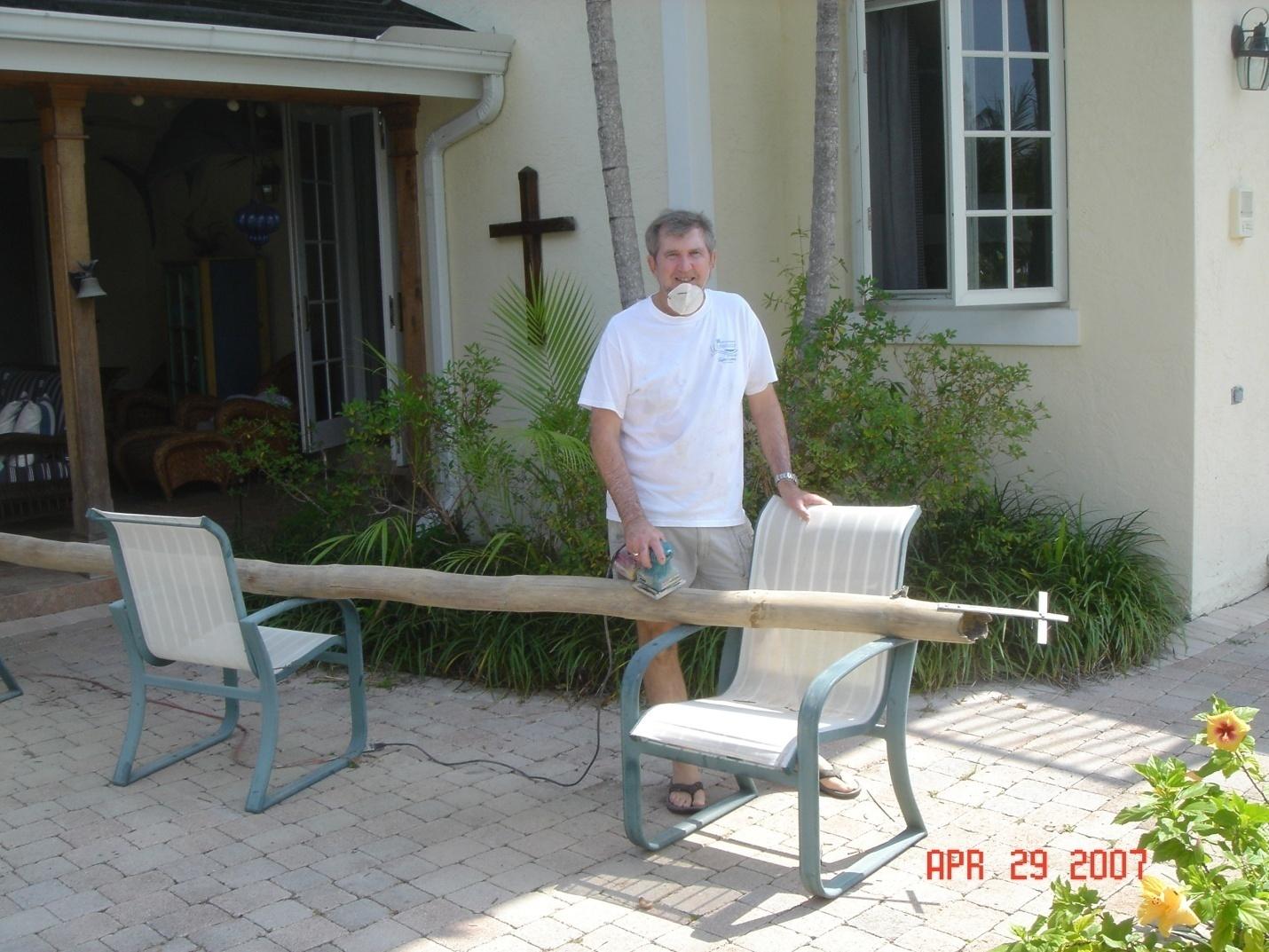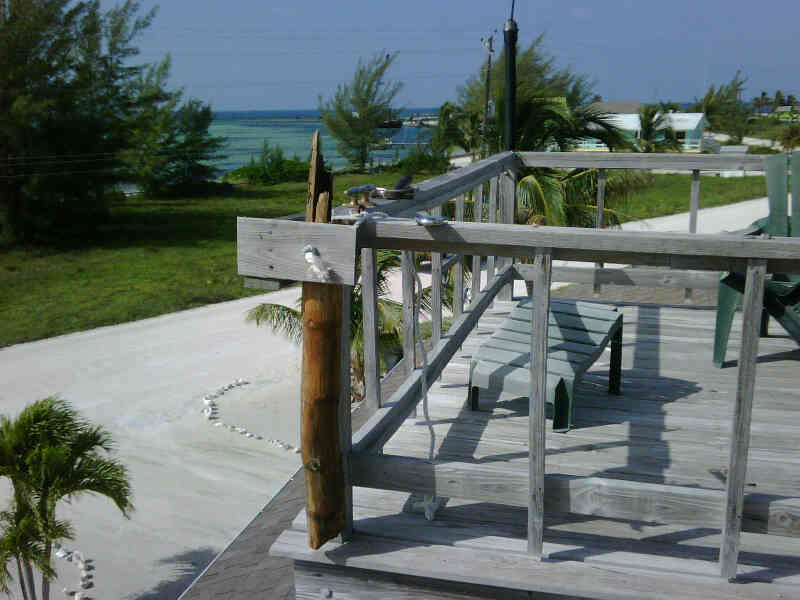M/T ALBINONI
Written July 9, 1998 &
Sept. 20, 2009
This story begins innocently enough on the evening news of February 7, 1994 at about 2330. Chauncey Naylor who at that time was our Shipboard Fire School Director. Chauncey a dedicated fire fighting professional called me on the telephone and said to turn on the CNN news channel. When I did, CNN was reporting a story of an Oil Tanker that had just blown in half. There was a map of the Caribbean and an explosion symbol on the map, which showed the reported location of the casualty ship. The 30-man crew was reported as missing at that time and the U.S. Coast Guard vessels and aircraft were in route to the site. The vessel’s location put it about 25 miles south of the country of Dominican Republic, which is on the Island of Hispaniola. Haiti is located on the west half of Hispaniola and the Dominican Republic on the eastern half.
Our Resolve team makes our living by providing help and assistance in these types of situations; therefore after listening to CNN I called the U.S. Coast Guard’s Search & Rescue Division in Miami, Florida. Since we work fairly closely with the U.S. Coast Guard we were given the name of the vessel’s owner/operator. I then made contact to the owners. The owners thanked me for the call and said that they had been trying to reach us as well. This was because we had previously assisted them in the past on some less than emergency situation.
The vessel owners only had limited information, which was that the entire crew was missing, and that the ship was in two pieces. Both sections although unattached were still afloat. The ship’s automated satellite distress signal was picked up in Europe and relayed to the U.S. Coast Guard in the United States. I negotiated an agreement with the vessel owners for two of my men Mauricio Garrido; V.P. of Operations and Chauncey Naylor Resolve’s Fire & Response School Director and I to immediately proceed to the casualty. Our mission was 3 fold, first to get aboard the two-vessel halves by the most expedient means possible. Second to find any wounded or dead crewmembers and evacuate them. Third we were then to make recommendations to the owners on what should be done with the two ship halves and if our recommendations were accepted to the owners, then we were to be prepared and equipped to promptly execute our own recommendations..
With a contract in hand I again contacted the US Coast Guard Miami and informed them of the plan. They were very appreciative of the fact that the vessel owners were proactive by engaging Resolve. The Miami Coast Guard immediately put me in touch with the US Coast Guard Search & Rescue Division (SAR) in San Juan, Puerto Rico. Coast Guard San Juan was the ones working the search and rescue operation. This was because San Juan was in a closer proximity to the casualty than Miami. Time, in situations such as these can mean life or death, therefore it was agreed and understood that the Resolve team would fly to Puerto Rico and get a briefing at the U.S. Coast Guard Search and Rescue (SAR). Operations office San Juan. After the briefing we were to proceed to the vessel location aboard a U.S. Coast Guard Helicopter. The plan being we would be lowered aboard and if there were any ship’s crew members aboard and found alive then the helicopter was to recover them and we would remove the dead using a tug boat that would also evacuate ourselves.
The morning reports were encouraging since the U.S. Coast Guard had found a raft with 15 men all alive in it. Later that day more men were found for a total 24. During this rescue phase the Coast Guard did an incredible job. We arrived at approximately 0300, the following morning in San Juan with all our equipment, which included fire fighting bunker gear, explosive meters and s.c.b.a. breathing tanks. We had made tentative arrangements for “C 4” explosives to be sent down if we needed to sink the ship halves. The reports from the surviving crewmembers was that there were men working in a ship’s double bottom tank under a fuel cargo tank in the mid ship section. At the time of the explosion the oil tanker “Albinoni” was doing approx. 14 knots.
The report that we got which was relayed to us from the surviving crewmembers was that the ship’s Captain and the Chief Mate were both on the main deck at the time of the explosion. Two other men were seen blown off the ship’s deck into the water without and life jackets. The Captain and Chief Mate were last seen lying on the deck by the explosion. The “Albinoni” had just off loaded it’s cargo of crude oil in the Dominican Republic for the nickel mine there and she was going back empty or in ballast to Venezuela to pick up another 120,000 barrels of oil.
On our arrival at the U.S. Coast Guard SAR Operations room we were shown a video that they had taken earlier in the day. We asked if the Coast Guard had attempted to put men aboard the ship to check on the ship’s Captain and Chief Mate who were reportedly lying on the deck but not seen in the video. The U.S.C.G. officer said “no” the officer stated “they did not want to risk live men for dead men.” This was a real surprise statement to me since this was not the Coast Guard I had been in some 25 years earlier. In our Coast Guard boot camp we were taught or drilled that “You must go out but you do not have come back”. Simply stated it meant that our duty was to go out on a rescue. The officer also stated that there was also the unknown factor as to why the ship blew up and could it happen again? After we watched the US Coast Guard video I asked at what time we could plan on a helicopter to put us on the ship’s bow section. The officer on watch then informed me in a visibly embarrassed manner that the Coast Guard had reviewed their policy and since we were civilian salvers, the U.S. Coast Guard could not deliver us to the casualty.
To me this was totally incomprehensible since here we were there fully geared, fully qualified and ready to do, in my opinion, their job for them. With two men lying on a ship’s sun scorching deck possibly still alive and two huge wrecks adrift in the shipping lanes. Further given my team and my own backgrounds there was no one was better suited for this task. I kept my temper and said that the helo only had to simply lower us aboard. Should the vessel’s Captain and or Chief Mate still be alive, then we’d want the helicopter to take them back. Should these men be dead then we would take their bodies and other bodies that may be aboard off when our tugs arrived to the wreck as previously agreed to.
The Coast Guard would not or could change their position. We had wasted enough valuable time in getting to Puerto Rico for this now non-existence aircraft ride. To me personally this was quit a blow since I was both an ex- U.S.C.G. Diver and Explosives Advisor as well as I had worked 4 years recovering torpedoes from helicopters and now I owning my own Shipboard Fire Fighting School etc. etc. so in my opinion there were none better than this team for this type of mission anywhere!
All the while I had a nagging feeling that the two men left aboard and lying on the deck were possibly still alive. We now had no options in Puerto Rico since there were no commercial helicopters with the fuel range required. I therefore elected to immediately fly to Santo Domingo, Dominican Republic. We arrived in the Dom. Rep. that mid morning and were greeted by Mr. Eugene Carboral the Minister of Civil Defense. Mr. Carboral was totally up to speed of the disaster since many of the crewmembers were Dominicans. Further he had been requested by the Spanish Embassy to see what could be done by the Dominican Navy. Spain became involved because the vessel’s captain was a Spanish citizen. Mr. Carboral has always been a close friend of mine from earlier missions. Unfortunately the Dominican Air Force did not have a suitable helicopter and there was only a 2 seat civilian helo with no inflatable floats for over water flying in distances like this. Of further frustration was that the Navy ships available and offered were too large and unyielding to be able to safely come alongside a dangerous now non-inerted crude tanker in high seas. Therefore we opted to charter a tugboat from the most professionally run tug company in the Dominican Republic, which was Remocoldores Dominicana.
We agreed on a certain tug. We were to leave at 0200 the following morning from the port of Rio Haina. We arrived at the dock a 0130 but found a different tug than the one agreed to. The company owner was also there and he informed me that at the last moment the other tug was required on an unscheduled large ship-docking job. Although I demanded the use of the other tug he said that he could accommodate us given our rush to get to the ship. By this time we hadn’t only had approximately 3.5 hours sleep in two days of traveling and logistics coordination. When I looked at this tug, which was called the Hispaniola and with the lingering personal conviction in my mind that there were two men lying on a ship deck could still alive, I then accepted the tug for the mission. Although the tug looked capable, the last words that I shouted to the tug owner who was standing on the dock in that predawn hour, as we pulled away, was “I wish that this damn tug was bigger”. That was the last time he saw this tug and nearly some of his crew.
Now finally we were under way a full 24 hours later than I would have ever dreamed, but we were under way. The wind was howling even stronger than it normally does south of Hispaniola. This morning it seemed to have a more of a menacing sound. We calculated that we would be able to get approximately 3.5 to 4 hours sleep before we would need to swing into full action. This was to be precocious sleep. In the salvage industry the most debilitating aspect of the jobs are when human casualties occur, caused in many instances to lack of sleep. When I hit the bunk I was out within minutes.
The bunks that Chauncey and I got were located in the tug captain’s stateroom. The bunks were arranged athwart ships on a port to starboard position. Approximately 1.5 hours out of port Chauncey who was in the bunk above me, woke me up and said Joe I think something is wrong with the tug. Half asleep I said why do you say that since the engines are running. Well I fell immediately back to sleep and within minutes a tug crewmember flings open our stateroom door. He is wearing a life jacket; he opens the small locker in the room and takes out the only two life jackets that are in the locker. Now with these two jackets over his arm he just as quickly departs without saying a word.
That obviously brought me wide-awake. When I went to stand up I found that I was standing on the deck of a tug with about a 10 to 12 degree port list. I did not recognize that earlier because I was sleeping in a sideways bunk. I jumped up the 5 stairs to the tug’s bridge where I met the tug’s Captain Dixon. He was also wearing a life jacket. When I asked him what the situation was, he informed me that all was under control and that the tug had developed a port list over the last hour. He further stated that we had only about 10 miles to go to get to the “Albinoni” My experience immediately allowed me to recognize the true peril at hand. I told the captain to turn the tug around and head into the now 12 to 14 foot seas and to try to angle back towards port. The captain only saw the wisdom in this action after I told in no uncertain terms that we now had to save our own ship first. Next I ran down into the engine room to find a frightening site. The port engine room door on the tug’s main deck was ½ underwater and the seal around the door was either not in the door or in terrible shape. Water was cascading down into the engine room from around this door.
The stern steering rod shafts were also pouring water into the engine-room and onto the two electric steering pumps. I pulled a rubber deck mat and tried to cover the electrical motors with it. At that point I stopped the chief engineer from transferring fuel from his low side, port fuel tanks since they obviously were contaminated with salt water. Since his port fuel tank vents were now underwater and already filling with salt water. I did not want to lose the main engines to salt water fuel contamination. To me the tug was lost unless we could somehow stop the progressive tank flooding caused in part by the high seas flooding the port deck vents. I climbed back to the tug’s bridge where the captain was trying to keep it into the seas and still try to angle a course back towards port. At this point I called the U.S. Coast Guard San Juan, Puerto Rico and put out a MAYDAY.
The Coast Guard already knew us and of our mission as well. As soon as I gave them our location Chauncey and I went aft on the tug. It was now day light and my eyes could not believe what I saw. It was that we had a 10 man Dominican crew in life jackets on the starboard forward rail. This was not good since this vessel normally runs a 5-man crew. Because the tug was going to be offshore working they doubled the amount of crewmembers. The crews’ normal shift while docking and undocking ships in port is 8 hours. Mauricio reports to me that although the large refrigerator in the galley is adrift and dangerously sliding back and forth across the deck he had to tell the cook to stop cooking eggs and prepare to abandon the tug. I guess denial is a strong force.
Once back aft by the tug’s towing winch I stripped to my jockey shorts and I tied a ½” nylon line around my waist. Chauncey tied the other end of the line to the tug’s towing winch. My plan was to plug up the fuel and void vents on the now underwater port side. Since the seas were huge it became a most difficult task. I tried to force rags into the submerged and flooding vent pipes. I could feel the water flooding into the vents, but unfortunately I could not properly hold onto the vessel and jam the rags the task proved to be impossible. This was because one moment I’m trying to force a rag into a vent pipe and the next moment a 12 to 14 foot sea has me and I’m in the deep blue ocean outside the tugs submerged side and looking down to the 4,000 foot abysses. In the next fraction of a second as the line snaps tight and I’m getting hurled in a radius across the back deck at about 2 knots and just missing deck bits and bulwarks. All the while I’m hoping that the tug does not decide to take a final plunge while I’m securely tied to it. After approximately 4 attempts at trying to plug vents I realize the elements and time won’t allow it and with a sigh of resignation to our fate I drag myself across the tilting back deck and quickly untie myself.
The tug list is ever increasing, as are the day break seas. Back on the wing of the tug’s bridge, above the now howling wind, I ordered the captain to deploy the life rafts, to which he replies to me that we don’t have any aboard. This is not a good thing. There is a small cork type float about 5 ft long and 4 ft. wide. It has a rope net bottom to it. The additional unsettling news is that, although there are 13 of us aboard, there are only 11 life jackets. Thirteen really never has been seen to be a lucky number has it? There are 10 crewmembers and 3 Americans. I get off another Mayday to the Coast Guard on the tug radio and inform them that we are getting off the tug before it rolls over. As we are getting ready to abandon the tug I put my clothes as well my shoes back on. Mauricio and Chauncey both take off their shoes. Although we discussed how they might need them later, they both opt to go without. Fortunately the tug also had two of the rigid round man overboard throw life rings. Chauncey took one and I take the other, this left the remaining men with life jackets. Unfortunately even these life jackets are the pleasure boat style and they only have one small strap that goes around the person’s back.
Just as we are all about to jump over the side, Mauricio stops me and he gives me back the piece of nylon line that I had used while trying to plug the vessel’s vents. We tied ourselves together with this line. This line most probably saved some lives because; despite the high seas were able to keep everyone together. One last time for me to the bridge and I stopped both the main engines and pull them out of gear. As the tug was settling in a bow straight up attitude we begin jumping in one at a time. When we hit the water I have everyone swim cross-sea. After about 10 minutes in the water the tugs sinks stern first. Since I now smell heavy diesel, I once again have everyone start to swim cross-seas. I repeat this 2 more times until I finally realize that the diesel I smell is not from the sunken tug’s fuel oil bunker slick, but the diesel smell is from me since I had gotten covered in diesel fuel while I tried to seal the flooding fuel tank vent pipes. This revelation did not embarrass me as I was now greatly relieved that we would not be forced to swim in an eye burning and gagging sea of diesel fuel. The tug had approximately 10,000 gallons of diesel aboard it when it went down.
Our next situation is that the aged chief engineer, who had a previous heart condition, starts to have heart palpitations. Using the small cork raft we get him into it. The seas are so high that it takes 6 men holding the side hand line on the raft so that the ailing chief is not catapulted out of it. At this point in time there is not a lot to do but try to keep our faces out of the breaking seas. Chauncey and I have an added challenge and that is to try to keep our bodies in these throw rings. In the howling wind Mauricio and I start the men singing different songs like row row row your boat in Spanish. Anything to keep the men’s mind off the situation. After some time I notice some of the men getting sick. Although it seemed strange to me, I also succumbed to it. The feeling was terrible but right after I vomited the threading water didn’t somehow seem so bad. I just hoped that the terrible seasickness feeling would not return. Vomiting in high seas with your head only inches above the water leaves room for improvement.
By my early 30s I started connecting the dots and became a man with fairly strong religious convictions, my first prayers to the Father above were that we needed to be rescued by helicopters. This was because the seas were so high that if a ship or a tug were to rescue us then undoubtedly there would be at a number of broken bodies from the seas slamming men against or even under a rescue vessel. But after about 15 minutes in the water and in 14 to 16 ft seas I modified my prayers to “any rescue would do”. We were in seas where there was about a 10 to 12 foot high rollers that were topped by a 6 to 8 foot coaming or breaking seas on top of the rollers. They were coming at us so hard and fast that it was hard just to breathe and not get a breaking or foaming sea in your mouth. At many points in time we had to cup our hands in front of our mouths just to breathe without ingesting water.
After about an hour and a half we spot a high-flying aircraft. It was at about 8,000 to 10,000 feet. We are able to distinguish that it is U.S. Coast Guard C-130 fix wing plane. It would appear then disappear into the clouds. Over the next 6 hours we see it no less than 6 times.
I assumed that they must have some type of infrared or other device that will allow them to locate lost seamen. The situation with the men in the water is rapidly deteriorating and to make matters even more difficult was the fact that the men had to fight to just to stay in their single strap life jackets. At this point in time I have to hold up an old timer who just cannot keep himself up right in his life jacket. Although the only thing I have is a throw ring around may waist, I am able to put my arms under the old timers arms from behind him, and to keep us both up I have a hold of the line that runs on the outside of the small cork raft that the chief engineer is in. All the Dominicans are watching me and I can read their faces, to me about 1/3 of them have already accepted the inevitable, so I was trying to keep them on their toes with different orders which Mauricio translates. About two hours after we had abandoned ship, we see a U.S. Coast Guard helicopter bearing right down on us and he is only about 1,500 feet high. Unbelievable as it was it just keeps on going. Here we were 13 men in a cluster with orange jackets, and a mini orange raft. If this helo that is looking for us can pass right over us in broad daylight we knew that we were in trouble. Worse yet is the fact that it seemed so low that we could reach up and touch it.
Déjà Vue, after working for 4 years jumping out of helicopters and recovering torpedoes, I had a real good idea what the odds were of us getting spotted in these high seas. I can remember many rough sea state days when our helicopters were 1,000 foot in slow flights to a basic hover and right above a 27 foot by 27 inch diameter, orange torpedo which were floating horizontally and yet we had tremendous difficulty finding them. Even though both the torpedo’s hydro sonic pinger and our helo radar transponder put us right on top of them. Yes I now knew that we were in deep yogurt.
Now with this latest fly over the crew’s moral sank worse yet. After another 4 hours pass and I am using all my energy to hold the old timer up all that I do is pray for strength. Thoughts are now going through my mind about what a wonderful wife and family I have at home and to be out here. When I left Florida on this job I expected that it would take 3 days, I figured that we’d get in and out with our quick and usual effectiveness. I was so certain of this that I told my wife Mary Beth that I’d meet her and the kids at our getaway house in Bimini, Bahamas for a few days rest. Now I had to wonder how she would handle the news that I am missing at sea. Since I am one of those people who think that I am never going to leave this earth I didn’t spend much time worrying about myself. When Davie Wright in our office received the call about our tug sinking in route to the job, he had to hold tight for awhile hoping that we’d reappear as quickly as we were lost, but after a number of hours passed he and David Walshe had to notify our families. They did this as tactfully as one can. My wife Mary Beth was actually heading out the door to the airport when she got this call.
Every once in awhile a large school of flying fish would spook near us and fly right over or beside us. I know what is probably spooking them. Although I usually can see fairly well under water, without a facemask, on this day I avoided looking underwater. As I didn’t want to scare myself or anyone with something that I might see below or around us. I did know that we would most probably get a warning before a shark would attack us. This warning would be in the form of a sharp bump or hit from either a shark’s pectal fin or its nose. Again drawing from my experiences while working at Andros Island, Bahamas on the U.S. Navy’s “AUTEC” Weapons Range as a diver we always got bumped by a shark prior to them coming back to take one of our fins or before trying to get a piece of us. Of course at Andros on our known high density shark dives, we were prepared and we carried short 14 inch cut off broomstick handles with a line attached around our wrists. We always tried to do the bumping first, which by the way normally is all that it takes, a good smack on a shark’s snout usually will keep a nosey shark away from you. I haven’t had to try this on a Great White thank goodness.
At this point in time I can remember our ride from the San Martin airport in the Dominican Republic to the capital city of Santo Domingo. On this early morning ride there was a man waving almost frantically to us as we drove up the road in his direction. We slowed down and to see a large, object, waist high to him, and as he stooped over it, he had the large nose pulled back and it exposed a mighty fierce looking set of teeth. . It was one of the largest shark heads that I had seen in years. Apparently that was how he sold sets of shark teeth. The area around the Dominican Republic is one of the most renowned regions for the concentration of these large predators. I had never seen this sales approach before or since, but at this point, threading water, I could have done without this memory. Approximately 4 hours after we abandoned our tug we spotted another helicopter. This one is on a course that will pass about a ½ mile to the east of us. We are all waving as this helicopter also just keeps on going. All the time the wind and seas seem to be increasing. Although the tug sank with 25,000 gallons fuel aboard, the heavy seas and wind will not allow an oil slick or sheen to be form and be seen from the air.
I am now watching some of the weaker men and I have them jockey positions to keep them a little closer to Mauricio, my old timer and me. At about the sixth hour I shout above the high wind to Mauricio. I tell him that I want him to repeat in Spanish verbatim the following. “Tell the men that I know that they all pray and that I think it’s about time we pick up the pace and we all pray together”. Mauricio does as I ask he swims around to all the men and when I have every ones attention we start the Lord’s Prayer, both in Spanish and English “Our Farther Who Art In Heaven/ Padre Nostros”. Within minutes that we finish with our pray, something catches the corner of my eye. I continue to look across the seas and I see this something on the top of every fifth to sixth set of seas away. I ask Mauricio, who is still near me, to look and see if he sees something to the west. Mauricio confirms he also sees something.
We had not seen anything all the time while in the water, not even a leaf, therefore I felt that it is worth a look. As you may imagine I had a few fairly good reasons building up in my mind why I should stay put. The greatest of these was my recollection of our ride from the airport. I did not want to be the lone fish leaving the school. Well I once again gave into duty. I had Mauricio take over holding the old timer up and I headed out. I must admit by now I was fairly fatigued and cold as well. I swam out about 150 feet and what I found was a large piece of Bamboo. There was nothing else. The Bamboo was approximately 14 to 16 feet long and about 5 inches in diameter. As I swam back to the men I thought that it could make a good pole for a flag. When I got closer to the men the only bright color clothes any of the men had were worn by Chauncey and Mauricio, but they both had on one piece white coveralls. The next surprise came when, as soon as I reached the men, the captain of the tug’s bright orange life jacket gave up the ghost. The entire side of his life jacket came completely apart and the thin flotation foam pads simply blew away on the top of a sea in the wind.
The tug captain, Dixon, who was the only crewmember that spoke English, looked at me and he obviously read my mind and said do you want to use this jacket as a flag. With a big “hell yeah” I took it and tied the torn jacket to the bamboo pole. I then helped the tug captain onto and across the Chief Engineer’s legs and ankles, who was on this cork raft. This also helped to stabilize the raft a bit more. With the jacket attached to the bamboo I tried but alone I could not raise our new flag and pole. So I had Mauricio assign to me 2 of the strongest crew to stay right with me. The three of us are able to raise it easily and it is at least 12 feet in the air with its bright orange jacket attached as a flag. We dropped it back into the water to save our energy. I then yelled out that the next time that anyone sees anything we will raise our new flag, Mauricio also translates this. Well as soon as the words are out of my mouth, Chauncey shouts out that he sees something on the horizon. It is so low it is hard to tell if it is an aircraft or a vessel. A few minutes more and we see that it is an aircraft. It is coming out of the relative same direction that the last two helicopters had come from.
This aircraft is on a course that will put it way out side of us and about twice as far of as the last helo that pasted us by. My two-man team and I replicate what looks like an in water Iwo Jima flag rising. At this same time we can distinguish that the aircraft is a helicopter. To our total disbelief this helicopter makes a 45 % course change and heads directly for us. The helicopter then pulls around into a hover just downwind of us. Within no less than 10 minutes there are 3 Dolphin class USCG helicopters, one behind the other. I was in quite an emotional quandary thanking the Father for answering our pray and sending to us something I could not begin to think I’d needed. I couldn’t have even thought that a piece of bamboo was what we needed. And if anyone went to their local Home Depot or Hardware store, today, they could not have picked out a piece of material better suited, that would float yet be both long enough, strong enough to hold a tattered soggy life jacket in 40 plus knot winds plus and still be light enough for three men to raise in those seas. To match that it must be also understood that there was not so much as a coconut, a twig or leaf floated by us in all the time we were in the water. Additionally at then 20 plus years at sea the only tome that I saw a piece of bamboo was working in the rivers of Guyana, South America.
There were many emotions going through my mind. Starting with, gee this is sure a nice way for the Coast Guard to pay me back for my 4 years in the Guard. Another train of thought was if only we had gotten that one Coast Guard helicopters on that first morning this near tragedy and additional personnel and resource risk and commitment would not have been necessary.
Further I thought how unbelievable it was and I wondered that if this had happened 18 miles off the Miami coast what would be the odds that I’d get even one helicopter let alone the 3 hovering above us. These were fairly overwhelming feelings, needless to say I was also quite relieved of myself imposed guilt trip that a number of these men would start to be lost because of the fact that I took on ship salvage as my occupation. Now, that highflying C130 is low and making tight circles above the helicopters. The first helo positions just above us and a Coast Guard rescue swimmer jumps into the water to join us. “It’s great to see you” I shout to him, then I pass the old man that Mauricio and I have been holding up and we get this old timer in the basket, he’s the first to go.
After a number of men are lifted into the first helicopter it heads off to Santo Domingo, the closest fuel stop as well as it’s the nearest medical facilities. The second helicopter pulls into a low hover and another Coast Guard rescue diver is deployed and he joins us. By now another event takes place. A fairly large tanker heaves to about ¼ of a mile from us to render assistance if we required it. The name on this tanker has the same name as the tug that sank from under us, “Hispaniola”. It has now been probably forty minutes since we raised our Bamboo and half of our men are already in helicopters. I start to wonder or doubt whether the Bamboo had anything to do with events. And looking up at all that flying aluminum I realized that I will never know if the bamboo had played a part or not in our rescue, well I guess that’s how miracles are supposed to go. We are brought to a certain point and faith is required after that.
Well as the story further unfolds, there are only four people left in the water. The two Coast Guard rescue divers, the Captain of the tug and myself. At this point I motion for Captain Dixon the tug Captain who is crouching in the mini raft by himself now, to swim over with the CG swimmer and into the lowered helicopter basket. The captain shouts above the rotor wash and wind, “no sir the basket is for you this time”. I, in turn yell back to him to get in the basket or I’ll drown you myself. That ended the debate and he is put into the basket by the Rescue diver. Our arguing we must have looked quite insane to the Coasty swimmers. My only thought was that I just wanted everyone out of the water so that I’d have peace of mind.
Well as it turned out when the helo picked up the Dixon the Captain it also was filled and in need of fuel. It immediately also departed for Santo Domingo. The last helicopter now moves into position and the rescue divers get me into their basket and I’m up and raised the 40 plus feet and swung into the helo. As I get out of the cramped rescue basket and into the helo the crew chief, who operated the basket rescue winch, shouts above roar of the rotors if I am Joe Farrell, I nod a yes and I shout back “let’s talk later, we must first get your men out of the water”. I felt that in the neighborhood that we were in us already pushing our luck with the hungries below. Once he recovered his two swimmers up and in the helo the chief shouts confirming if I’m all right. I nod yes again, then he further explains that the U.S. Coast Guard San Juan wanted for him to tell me that “they were going to find us no matter what” he shouted that the U.S. Coast Guard had already scrambled two long range Shikorsky helos from Opa Locka, Florida and they were in route. They were on the 1,000-mile trip to join the search for us. He said that the Captain wanted me to know this as well. Being a man of few words at times like these I just simply told the chief to pass along my thanks.
My burning thoughts were, if only we had gotten the one helo as agreed to none of this would have happened. Since I was also truly grateful to the men in these helicopters who risk their lives for others as a steady diet, I kept silent and enjoyed the ride.
As I sat huddled in the right rear corner of the helo shivering my mind started to wander back to our original mission. Are the Albinoni’s captain and mate still lying on a scorching deck or are they already dead. My thoughts are broken when the helo crew chief shouts to me that he was the one that spotted us. He continues and Mr. Farrell I have to ask you a question. When he said this it at first it doesn’t yet sink in. I told him that he could credit himself with saving at least two men that were just about to give up. I further explained that if nightfall overtook us that I believed that there would only have been ½ of us left by daylight.
The chief interrupts me and he said “but Mr. Farrell you do not understand at the time I spotted you we weren’t looking for you”. Now as you can imagine this young man had my full attention. As he continued he shouted in the noisy helo that the area that we were located in was already overflow twice. He further said that they were to search in an adjacent search quadrant and they were only transiting this area. He said that he had turned his head to lean towards the pilot whose name I read on the back of his helmet was Peacock and as the crew chief is shouting to me, he demonstrated how turned towards Peacock, and he continued, “and as I was talking to the pilot through the mike, I spotted something above the seas”. He comes to all stop and looking me in the eye, he asks, Mr. Farrell what did I see above those seas today. Well I herein must write an apology to that crew chief today. Unless he reads this he still wouldn’t know what he saw, because I simply had to turn my head away from him so that he did not see me cry as I asked for The Fathers Forgiveness for doubting his hand and presence in this. (If the tug captain had his way I would not have been in this very Helicopter.) Blessed are those who do not see but believe, I guess you could have called me Thomas that day.
When we arrived in the Dominican Republic’s San Martin airport, we landed beside the other two U.S. Coast Guard helos. I am met once again by my old friend Eugene Carbohol. Eugene has doctors and nurses waiting for us at ambulances on the airport tarmac. We are actually quite sun burned, but otherwise intact. Eugene was also personally air borne looking for us in one of the Dominican Air Force plane search planes. At this point I find out that the Coast Guard C 130 did not have any special search equipment but it did have a very real roll, as I was told it, was providing air traffic control so that search helo would avoid a mid air collision. After a few bear hugs, and as we are moving through the main air port terminal and I lean over to Eugenio and ask him to help me get my two men Chauncey and Mauricio onto a stateside bound flight. When Mauricio and Chauncey get wind of the program they asked me what I was going to do. Stuck for an answer, I said well I couldn’t obviously take two guys who don’t even have shoes much further. They both said that they would not go home without me. They both knew that this only meant that they would be once again going out to and up against a ship that had by now most probably already killed six men as well as it almost got a piece of us.
First a hot shower, a number of Irish whiskeys and we then formulate a new battle plan. From the hotel we make arrangements and hire a Lear Jet from Ft. Lauderdale, Florida. When the tug sank we lost all our equipment. The worst part was that in our efforts to save the tug and all we actually left 3 intrinsically safe and water proof VHF radios on the tug to sink. These sure would have made our rescue search much easier. The Lear is to re-supply us with replacement equipment from our base; Port Everglades about a ¼ mile from the airport. By 2230 the Lear Jet is in the air and to arrive at 2345 at the Santo Domingo International airport. There is one slight oversight, 15 minutes after our jet departs Ft. Lauderdale international airport we are informed that the San Martin airport closed down at 2230 due to some scheduled runway repair.
A quick call to Eugene and him in turns calls the President of the Dominican Republic, Mr.Balaguer at the president’s home and like magic one reopened airport. There were 3 Army Generals and 2 Admirals to greet the re-supply jet with us and they personally loaded our replacement gear into our vehicles. At Daybreak we are once again enroute to our mission. This time we are aboard the tug “Don Pablo” from Ponce, Puerto Rico. The Albinoni’s owners brought in this tug while we were still the missing.
This tug was larger and more capable, we hoped. The aircraft reports put the two hull sections about 12 miles apart from each other and the bow was in a current that would actually put it aground on the south coast of the Dominican Republic within about 14 hours. U.S. Coast Guard aircraft were to vector us to the floating bow section. This section was about 450 feet long and riding about 25 feet above the seas. After a number of hours underway we picked up the bow section on the radar, as we close on our destination and possible fate we also experience what most men feel when they are about to go into harm’s way. And that is that although the task is clear the outcome is still stressfully uncertain.
On our arrival alongside the ghost like bow we make a slow maneuver alongside and around the wreck. We are only about 20 feet off the vessel in the still running sea and we circle her trying to spot the two men reported to be lying on the deck. We do not see any bodies nor do we detect any significant explosive vapors coming off the wreck that could indicate another possible immanent explosion risk. The vessel is making and extremely loud eerie sound almost what I would imagine that a mortally wounded whale would make. The noise is produced at the location of where the ship was torn in half by the explosion and it is created by the sections of twisted, tangled and mangled steel that is being flexed by the seas. The seas have now moderated since our swim test the day before and although they are still running 6 to 8 feet the tug captain is able to get us alongside the wreck without sparks or damage to his vessel.
We take off all metal rings to watches and anything that can create a spark and within 2.5 minutes we pass all our replacement gear of breathing tanks, fire fighting bunker gear and explosives meter aboard the Albinoni. Once aboard our first task is to qualify our own risk exposure from re-explosion. We do this within about 10 minutes using our explosive meter.
The main deck air LEL, explosive level, itself in most areas is below the explosive level. Next we start a comprehensive search of the main deck and forward bowfin’s locker. Our findings are disturbing and disappointing as we find a pair of shoes laying in position as if someone had been standing in them but then me was blow out them. They are at a position of about 15 feet away from the severed end of the ship and facing the blast area a few feet to the side of these we find a trail of something on the deck as if something or someone had been dragged across the deck. This trail leads over to the side of the ship where the person evidently went overboard.
Those were the only signs of human existence aboard. This was a disappointment to us given the risk we had already taken to get there. The two-crew members, who were assumed dead, the Captain and Chief Mate and although last seen by the crew as being blown to the deck were both obviously still alive at the time. They evidently had to crawl from where they had laid and dragged themselves over the side and into the sea.
This is the only explanation as to why they were not aboard the wreck when we arrived and they have never been seen again. Therefore we summarized that if we had been able to get aboard the tanker as initially planned, via. A U.S. Coast Guard helicopter then these men may have had a chance to live. The old saving is that you can’t cry over spilt milk was sure hard to accept for us since we had risked so much in trying to get there as soon as possible and undoubtedly we would not have taken that tug out in such sea conditions if it were not for these 2 men.
Our mission has again taken on another sense of urgency because the vessel’s bow section; the section we are on is closing or drifting to the South Dominican Republic Coast in an amazing ocean current speed of about 1-½ knots. It is estimated that this hull section could actually be on a shoreline coast within 7 to 8 hours. So we commence to flood the ship. In all the confusion we have a mix up in the delivery of our “C 4” explosives. Therefore we must sink this section by free flooding it. Since the hull was torn in half we find that by opening all the on deck fuel transfer valves we can sink the vessel. The reason for this is because all the 8” and 10” fuel transfer pipe lines that run from the pump room to the forward end of the ship were below the water and when the ship blew in half these lines were cut in half as if done by a guillotine, except the pipes were not crushed or crimped at all. By opening the large manhole/Butterworth deck openings we allowed for the vessel to continually settle or flood without trapping air. Although the vessel had a small amount of residual oil in her tanks we had only one choice, which was to sink her. The only other alternative of bringing her into a port, with a trailing heavy type oil slick and given her risk of sinking in a port did not appeal to me.
In an effort to try to find the cause of the explosion I climbed up above to the main deck catwalk that ran above the entire deck mid ship all the way to the bow. When I surveyed this area toward the after end of the ship near where the hull was separated I came to an oxygen and acetylene cutting rig. These items are used in the welding trade to cut steel. These bottles were connected to a hose and I found that both the bottle valves were in the full open position. I then climbed down from the catwalk and followed the twin hose on the deck, what I found did not surprise me. The cutting hose was severed and its end was being thrown around in the seas at the destroyed ship end. When I pulled up the hose from out of the water there was only a scorched and severed hose end. It became clear to me that I was holding the very item that was the root cause of this needless loss of life. The crew was working in the bottom of the ship with this cutting torch when, most probably, the highly explosive residual vapors of benzene and crude oil light ends ignited when the torch flame met these vapors.
Mean while Chauncey and Mauricio continued opening the vessel’s cargo deck valves and Butterworth manholes. Within a number of hours the ship starts to noticeably settle lower at the stern. As the ship continues to slowly go down by the stern we start to make our way off the “Albinoni” and back onto our tug. It is much easier to get off now since the wreck has sunk a good 20 feet lower by the stern. As the ship is settling deeper and deeper so is the sun. During the continued monitoring of the vessel sections drift course and locations to provide notice to other ship traffic by the U.S. Coast Guard they reported that the stern half of the ship with the engine room andIi accommodation simply disappeared. It was surmised that it sank in the high seas. Our mission is coming to a close, almost.
As the “Albinoni’s” aft bow section goes under, her bow continues to rise and just stands upright. The drama is unfolds ever so deliberate but slowly. As the bow starts to get higher and higher, we all look at each other and I yell to the tug Captain for him to back down and hard. The bow stands about vertical into the twilight sky in a most menacing way. It is now standing up in the air at least 200 feet, or as high as a 20-story building and it just seems to defy gravity. We all know that it has to sink because we have opened all cargo valves and all the large deck manholes and Butterworth tank openings, but none of us on the deck of our tug is sure that it will. The vessel is now making the most awesome noises, that of steel ripping to anchor chains being thrown on end in their chain lockers. At this point I can believe and expect anything.
I again motion to the tug Captain to get us still farther away from this man-killer. I would prefer not to see it roll over and down onto us. After no less than 15 minutes of it standing straight up in starts to go down straight down. It picks up speed and with a tremendous loud gush of air and she’s gone forever.
With a major sigh of relief from all of us the tug gets underway and we head back to the Dominican Republic. I thought this would have been the end of the story but about 6 months later while at our getaway house on South Bimini, Bahamas. Mary Beth, my wife and I walk along the beach and we come across a piece of bamboo lying on the beach. If this is not the same bamboo is identical to the one that was instrumental in our timely rescue. I could not believe it, as it is the same length and diameter, its one side is cover in barnacles and small mussels hanging on it. I explain our find to Mary Beth and then recall that the northerly currents from the Dominican Republic do merge with the Gulf Stream and would indeed allow for our piece of bamboo to be here on Bimini. In actual fact on this very location about a year earlier a small boat with approximately 150 Haitian refugees also drifted ashore there. Most were near dead from dehydration.
So as not to lose the bamboo again I took it to my house, which is only about 2,000 feet away. I have made a mast out of it and mounted it on my widow’s walk above our house we call the Compass Rose. When we are in Bimini the kids and I raise it and hang our pirate flags to country on it. I also mounted a small crucifix that I made on top of it.
This story still has had one more twist. On July 25, 2009 my son Joe III was on Bimini with his buddies and they were cleaning fish that they had just spared while free diving. A storm cloud system moved in over them and as Joey was looking towards our Compass Rose house he actually saw a bolt of lightning hit the house roof and then deflected and struck the bamboo and he saw the bamboo actually explode. They were only 200 feet away and as he said it was like a bomb went off beside them. The bamboo blew into a hundreds of pieces no bigger than 4”x16” slats. When I told Chauncey about the irony of this that in the 15 years of this bamboo was on the roof that my son at that particular moment in time was actually looking at it when it exploded from the lightning hit. I surmised that it exploded because of the many large isolated air chambers that make up bamboo. When I emailed Chauncey’s about this his response was that “I guess the God Lord figured that we did not need it any longer”. In actual fact this last incident prompted me to finish writing this story.
We have done and my teams continue to do numerous other risky and equally challenging jobs. In all our endeavors I now personally always enlist the power pray. I am continually amazed at the results as it sure works for me. I am frankly embarrassed to state this being married with kids but I have been one of those people who gets killed but it just never takes. A few years back when I won the Ernst and Young award for Entrepreneur of the Year for the State of Florida for Services and I addressed the distinguished audience, I summed up my feelings by saying that I want to first thank the Good Lord up above for having a sense of humor for keeping a piece of work like me around and then for a wonderful wife for staying the course with me.
Joseph E, Farrell, Jr.


